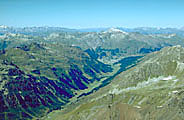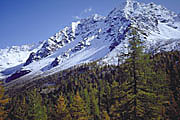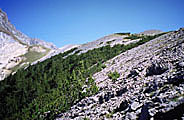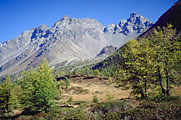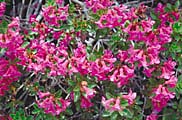 |
|
|
|
|
|
|
What is a mountain tree ? The term "mountain tree" and thus the altitude of the upper tree limit is not easy to determine (Holtmeier 1967, 1974, 2000; Ellenberg 1996). A mountain tree is characterized as a plant penetrating the winter snow cover with its top branches. Since the average depth of winter snow cover varies from place to place, it is not relevant to indicate a generally valid average for a minimum tree height. Under the protective snow cover, small individual bush-shaped trees climb far above the tree limit. The tallest of these small types of trees - usually only a few decimeters high - then form the tree species limit. The latter is not a clearly defined altitude boundary but a boundary which is closely connected to local climatic factors. |
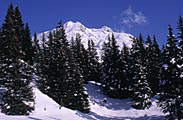 |
| 1 - Subalpine Picea abies
(Norway spruce) forest near San Bernardino in February, about 1600m, Grisons,
Switzerland Photo: C. Burga (150K) |
|
What is a mountain forest ? The upper forest limit is generally the most striking altitude boundary of mountain forests at the transition from the subalpine forest belt to the alpine zone. But it is not always clear what is meant by the term mountain forest (there are different geobotanical and forestry definitions of "forest"). In general, woods must have a certain density (canopy density of 40%), a minimum height (about 3 to 5 m), and a minimum area (about 100 to 2'000 m2) to be considered as a forest (see Bachmann 1964, Schweizerisches Landesforstinventar 1988, Körner 1998, 1999). In most cases, there is a transition zone between the upper forest and the tree limit called timberline ecotone (see Burga and Perret 2001). |
2 - Altitudinal variability of the timberline ecotone of an Alpine valley
(Picea abies / Norway spruce, Larix decidua / European larch,
Pinus cembra / Swiss stone pine), Dischma valley, Davos, Grisons,
Switzerland |
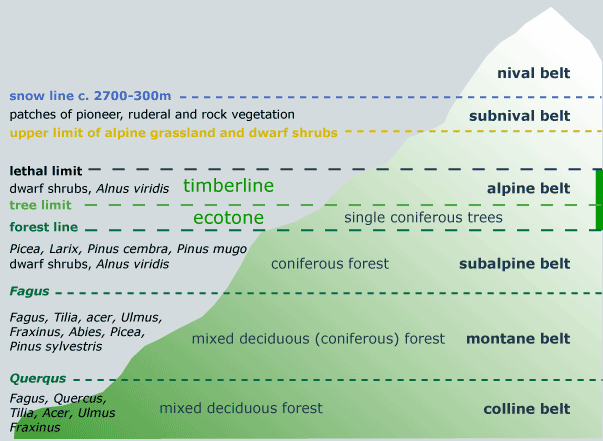 |
|
Both forest and tree limits are determined
primarily by: |
|
|
Heat sums Different authors have also tried to establish heat sums to determine the forest limit: according to Ellenberg (1996), Turner (1970) or Turner and Blaser (1977) at least 100 - 110 days with an average air temperature of 5°C are needed at the alpine forestlimit for tree growth to be possible. The 10°C July isotherm is also often used as a rough approximation of the forest limit altitude. However, since the subalpine forest limit can be formed by several different trees (e.g. Swiss Central Alps: Pinus cembra/Swiss stone pine and Larix decidua / European larch; Prealps: Picea abies / Norway spruce), one has to consider that such heat sums and temperature limit values should always be related to the species of tree concerned. |
|
Transition zone ("Kampfzone") Furthermore, the local climatic conditions, and thus the daily and annual temperature patterns are different in different mountain regions, so that temperature averages will a priori only be a very rough approximation of the temperature requirements for the trees forming the forest limit. The structure of the upper forest limit in the Swiss Alps, for example, is often characterized by a transition zone ("Kampfzone"), which can have an extension of 300 or more meters of altitude and which, besides alpine pastures often consists of dwarf shrubs (mainly Rhododendron ferrugineum, Alpine rose) or is partly dominated by populations of Pinus mugo ssp. mugo (mountain pine) or Alnus viridis (green alder shrub community). Other natural transition zones can be seen in some Central Asiatic mountain regions, in Western and Northern America or in some tropical mountain regions (e.g. Bolivian and Chilenean Andes, high mountains of East Africa, Mount Kinabalu/ Borneo or New Guinea). |
 7 7
 8 8 |
|
|
|
Holtmeier F K, Die Höhengrenze der Gebirgswälder , 2000, p.216-224. |
|||
29 August 2011 |
||
| |
||
